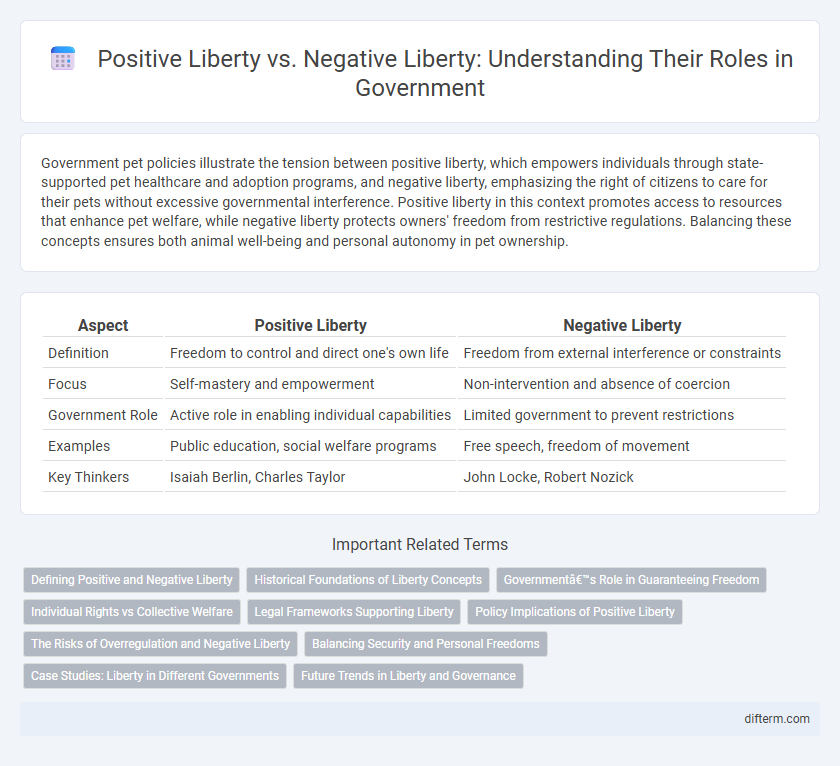Government pet policies illustrate the tension between positive liberty, which empowers individuals through state-supported pet healthcare and adoption programs, and negative liberty, emphasizing the right of citizens to care for their pets without excessive governmental interference. Positive liberty in this context promotes access to resources that enhance pet welfare, while negative liberty protects owners' freedom from restrictive regulations. Balancing these concepts ensures both animal well-being and personal autonomy in pet ownership.
Table of Comparison
| Aspect | Positive Liberty | Negative Liberty |
|---|---|---|
| Definition | Freedom to control and direct one's own life | Freedom from external interference or constraints |
| Focus | Self-mastery and empowerment | Non-intervention and absence of coercion |
| Government Role | Active role in enabling individual capabilities | Limited government to prevent restrictions |
| Examples | Public education, social welfare programs | Free speech, freedom of movement |
| Key Thinkers | Isaiah Berlin, Charles Taylor | John Locke, Robert Nozick |
Defining Positive and Negative Liberty
Positive liberty refers to the capacity of individuals to act upon their free will and achieve self-realization through access to resources, opportunities, and support provided by the government. Negative liberty emphasizes the absence of external constraints or interference, ensuring individuals have freedom from coercion and restrictions imposed by others, especially the state. These two concepts frame debates on the role of government in either enabling personal development or protecting individual autonomy by limiting its own power.
Historical Foundations of Liberty Concepts
The historical foundations of liberty concepts trace back to Enlightenment thinkers such as John Locke, who emphasized negative liberty as freedom from arbitrary governmental interference, while Isaiah Berlin introduced positive liberty as the capacity for self-mastery and collective self-determination. In government theory, positive liberty aligns with state intervention to create conditions enabling individual autonomy, whereas negative liberty prioritizes limiting state power to ensure personal freedom. These competing perspectives shaped modern democratic institutions and constitutional frameworks by balancing individual rights and governmental responsibilities.
Government’s Role in Guaranteeing Freedom
Positive liberty emphasizes the government's role in enabling individuals to achieve self-realization through social programs, education, and economic support, ensuring equitable access to opportunities. Negative liberty restricts government intervention, prioritizing the protection of individual freedoms from external constraints such as censorship or unjust laws. Governments balance these concepts by providing fundamental rights and social services while safeguarding personal autonomy and limiting arbitrary interference.
Individual Rights vs Collective Welfare
Positive liberty emphasizes the empowerment of individuals to fulfill their potential through active participation in collective decision-making, highlighting the role of government in securing welfare and social justice. Negative liberty prioritizes protecting individual rights by limiting governmental interference, ensuring freedom from coercion and preserving personal autonomy. Balancing these concepts involves navigating the tension between safeguarding personal freedoms and promoting the common good within democratic governance.
Legal Frameworks Supporting Liberty
Legal frameworks supporting positive liberty emphasize the role of government in enabling individuals to achieve self-mastery through accessible education, healthcare, and social services. Negative liberty frameworks prioritize protecting individuals from external interference by limiting governmental powers and safeguarding civil liberties such as freedom of speech and property rights. Balancing these approaches within constitutional and statutory laws ensures both empowerment and protection of individual freedoms under the rule of law.
Policy Implications of Positive Liberty
Positive liberty emphasizes the role of government in enabling individuals to achieve self-mastery and access essential resources, shaping policies that expand education, healthcare, and social welfare programs. This approach supports interventionist measures designed to remove social and economic barriers, ensuring equal opportunities for all citizens. Policies grounded in positive liberty prioritize collective empowerment and active state participation to enhance individual freedoms beyond mere non-interference.
The Risks of Overregulation and Negative Liberty
Excessive government overregulation poses significant risks to negative liberty by restricting individuals' freedom to act without interference. When state control limits personal choices and market activities, it can stifle innovation, economic growth, and individual autonomy. Safeguarding negative liberty requires balancing necessary regulations while avoiding pervasive state intervention that undermines fundamental freedoms.
Balancing Security and Personal Freedoms
Balancing security and personal freedoms requires understanding positive liberty as the empowerment of individuals through government actions that ensure safety and equal opportunities, while negative liberty emphasizes protection from government overreach and interference. Effective governance must integrate policies that uphold fundamental rights without compromising national security or public order. This equilibrium supports societal stability by safeguarding civil liberties and enabling citizens to exercise autonomy within a secure environment.
Case Studies: Liberty in Different Governments
Case studies reveal that positive liberty flourishes in social democratic governments like Sweden, where state intervention ensures access to education and healthcare, enhancing individual autonomy. In contrast, negative liberty is most prominent in libertarian-leaning governments such as the United States, where property rights and freedom from government interference are fundamental. Countries like China demonstrate complex interactions between these liberties, combining authoritarian control with state-driven economic opportunities, challenging traditional liberty paradigms.
Future Trends in Liberty and Governance
Future trends in liberty and governance emphasize the balance between positive liberty, which advocates for empowering individuals through access to resources and opportunities, and negative liberty, which focuses on protecting citizens from undue government interference. Advances in technology and data-driven policymaking enable governments to enhance positive liberty by providing personalized social services while maintaining oversight to prevent encroachments on personal freedoms. Emerging frameworks in digital governance reflect a shift toward hybrid models that integrate citizen empowerment with safeguarding individual rights, shaping the evolution of liberty in modern democracies.
positive liberty vs negative liberty Infographic

 difterm.com
difterm.com